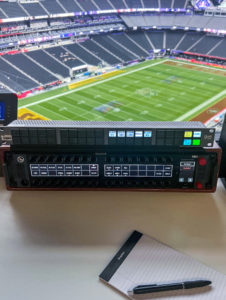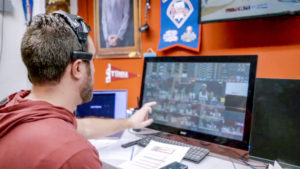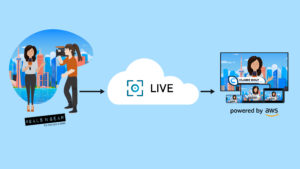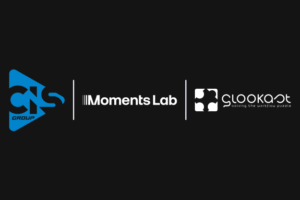
We spoke to IABM Global Engaged Partner, Tom Griffiths, Director of Technology – Content Supply & Distribution at ITV, about the business and technology trends he foresees for 2020 and beyond, and how IABM members can help him stay ahead. He has plenty of insights on how the relationship between tech vendors and users is changing, and excellent advice for everyone on the supply side on what he’s looking for – and how he wants to partner in the coming years.
How is the move to direct-to-consumer models influencing your investment in media technology?
Fairly fundamentally, actually – across the board with the possible exception of the production area of our business. Direct to consumer has been influencing our investments in media technology pretty much since I started at ITV in late 2013.
In the very early days, OTT delivery was built as a thing on the side – run independently from the core, cash generating linear broadcast business. All the time I’ve been at ITV those two worlds have been coming closer and closer together. The most obvious example of that probably would be what we call our content supply chain – everything from managing the ingest of assets, through to the delivery out to both linear and VOD platforms. But also, the planning and data management systems around this like content scheduling, metadata, content catalogue and rights.
We now look at linear and VOD much more holistically. Clearly there are specific requirements for broadcast via satellite or terrestrial TV versus delivery of ITV Hub or BritBox over people’s broadband and there are clearly still discrete elements to that in terms of investment, but we’re looking wherever possible to unify things and avoid having separate, dual paths. This covers everything from how we ingest and then deliver content, through to our operational teams, but also when we’re replacing or transforming some of the planning applications, thinking about both domains.
For example, we started a project last year initially to digitise some of our upstream linear schedule planning processes. Now, you could do that in and of itself just to make the process more effective for linear broadcast. But we’re thinking much more about a future, more direct to consumer driven world, where the way that we plan content isn’t just about what time it’s going to be on air – it’s also about a windowing strategy. When is it on a linear channel? When’s it going to be on ITV Hub? When’s it going to go on BritBox – which order am I going to release it on those platforms? And therefore when I’m looking at media technology, whether it be investment in products I’m buying or in terms of building something ourselves, I’m thinking about all of those parameters – trying to build things which are reusable in all of those different domains.
One of the challenges you have when you are trying to scale and enhance new products like BritBox while maintaining existing linear channels is that you inevitably end up with some double spend, unlike a new entrant who’s come straight into the direct to consumer world. Every UK, European and American broadcaster is contending with this problem. We’re not about to switch off our linear broadcast channels by any stretch, because there’s a lot of life in them yet, they’re still highly valued by our consumers; they are key revenue generators. But we also have to recognise that while they’re not collapsing, they aren’t the services that are growing. So we need to make them as cost-efficient as possible so that we can invest the savings into building out the new platforms of the future. That thinking is playing its way into everything from the renegotiation of contracts through to when a system is due for a refresh, thinking really hard and fast about simplification. We’re looking at processes and how our channels are available on different platforms to make sure that every individual location at ITV is worth having. Investment is definitely pivoting towards future facing platforms and away from more traditional platforms.
This change creates the most pinch for any vendors who are locked into traditional platforms and traditional solutions – although I think most of them have smelled the roses and are doing something about it.
With the move to as-a-service models accelerating, how are your relationships with suppliers changing?
Completely. There are some places where it’s still a ‘fire and forget’ buy then just run approach, but not very many, and where that is the case, it tends to be more where we’re still buying what you might call infrastructure orientated solutions. Increasingly, that’s not the consumption model that we’re operating with.
With as-a-service offerings, there are two considerations for me. Firstly, how do I engage commercially with a vendor? And secondly, how does that vendor’s product manifest itself to me?
Let’s look at Software-as-a-Service. Traditionally, if we were buying some software, you’d buy a software licence and you’d buy your own compute power in your own data centre, and you’d install it and run it and upgrade it from time to time; essentially, you’re looking after all of it. The same was true for hardware based on-premise solutions. Whereas Software-as-a-service models are predicated on them offering you that software as a “managed service” where effectively they’re either hosting it themselves in private cloud or hosting it by proxy in the public cloud. So it’s not my compute, it’s not running in my data centre – all I need is the connection via the internet and a browser.
This changes the consumption model quite a lot. We’re driving quite heavily in that direction, because we have a strategy to exit our data centres. That necessarily doesn’t include virtualising our studios – I think the physical studio is still here for some time to come. But when you’re talking about more generalised kind of business applications – things like scheduling, rights management, advertising systems, or other business planning systems – but also increasingly more compute intensive applications like video transcoding, playout and other areas, they all fall into that domain. Exercising our strategy of moving out of our data centres essentially means moving into the cloud – not automatically Amazon or Google though frequently that is the case, but at the very least, into somebody else’s data centres.
And as long as they know how to run data centres, they know how to well architect and manage the platforms and products they are building so they integrate well with our broader technology estate, they can prove to us that they know how to manage things like cyber security, and the performance and reliability of the as-a-service provision is good – then I’m happy.
This means there’s a more involved relationship with vendors because typically with software-as-a-service, we are talking about multi-tenanted solutions where making an upgrade for one customer means an upgrade that affects everybody. That potentially limits some customization depending on how they built it. And sometimes that means that if we really need something to be customised, we have to build that customised bit ourselves. It also means that building a joint understanding of priorities and roadmap are key, to make sure you stay aligned. I think it also changes the relationship because actually there is a kind of a risk on our side – because we’re now more beholden to that company continuing to support that particular service. In the old model, if the vendor decided they no longer wanted to sell a product, we’d still got the software, and while we might not get any support from the vendor any longer, as long as it doesn’t break, we can still use it. Whereas if it’s as-a-service, they could literally pull the plug and then you’ve got to go find something else to replace it pretty quickly.
On the commercial side, I think it is it is possible to consume something as a service and still pay for it in a relatively traditional way – for example I could still pay for it on a fixed 12 month basis or minimum term contract. With smaller companies, where they’ve got the basis of a product that we want, we’ve asked them to partner with us to develop that product into something more substantial. That means quite a big commitment from their perspective in terms of the amount of effort they’ve got to put in, so they need to know that there’s going to be something in return. In some cases like this we’ve entered into minimum term two-year contracts or similar.
But I think there is definitely much more – and increasing – consumption on a more flexible scale up, scale down, as-you-go basis. At the most basic level, there’s the consumption of pure compute – the classic Amazon Web Services model – where you are literally paying minute by minute, day by day, and that very much puts the emphasis on you to optimise that cost because it’s actually a rate card – enabling us to temporarily expand consumption when we need to meet a heavy demand for Love Island, for example, which, because its viewers are mostly the younger demographic, tends to be watched equally online as over the air. Another interesting area is pop up type services, something we’re very much exploring at the moment. As an example, traditionally, you’d end up building a playout chain with a whole load of physical infrastructure. And you’re going to have to pay for someone to run it for a few years, regardless of whether you’re using it or not – which tends to motivate you just not to do it. The pop-up channel is predicated on the vendors having a pay as you go model because it doesn’t matter if they’ve got a technology platform you can turn on or off if their business model still requires you to pay for a year up front.
As the industry increasingly moves towards cloud-based infrastructures, how can small media technology suppliers remain relevant to your business?
You could argue that cloud-based infrastructures actually make life easier for smaller vendors rather than harder for them. Unlike the hardware-based past, they don’t have to make massive investments – they can just buy some cloud compute and write their software without having to buy all the servers and everything else – they can just turn it off when they’re not using it. At shows, rather than having to invest in a whole booth, they can just take a pod on a major vendor’s booth – and benefit from all the traffic it naturally attracts. I would say we’ve actually seen an increase in the number of small, niche players in the last four or five years.
I also think we at ITV are interacting more directly with smaller players than we perhaps traditionally would have done in the past. If I think back five or ten years, if we were working with a small company, we would tend to want to get a larger player to prime them in front of us – a company that knew how to bring a product to market and to provide all the support services. Otherwise you’d be worried they just wouldn’t be able to do it on their own, whereas now we’re much more open to working directly with smaller suppliers.
That’s not to say that there aren’t still risks around small players – will they still be here in a year’s time? But some of those risks exist with big players. Just as with the traditional broadcasters v. new media discussion, it can be harder for traditional suppliers to adapt and change than it is for somebody who’s small and hasn’t got some of those organisational constraints.
As we move to as-a-service, if we are buying services from small suppliers as if they are out of the tin – a little widget which I can use and I don’t need to do much more – I’m going to make that little widget fit into my wider system and that’s great.
This might sound stupidly obvious, but my first message to small media technology suppliers is: offer me something that I want! Also, today people are much more interested in an ecosystem where they can buy best of breed products and join them together rather than the end-to-end software or hardware solutions of five to ten years ago. Cloud based infrastructures and modern software development and integration techniques like APIs make that much more achievable today. It’s enabled companies like ITV and other broadcasters to almost become our own systems integrators, where we buy a few products and are quite happy to do the bit in between that joins them together to work in the way that we want. So we might buy a particular product or service and use it in a different way from somebody else, but that’s okay because we’ve done the bit that makes it work differently for us, rather than saying to the supplier, we want you to bend your products out of shape.
On other occasions, we’re saying “you’ve got something really good there and we’d love it if it also did x, y, and z. Does what we want to do line up with your vision for your service or your product? And if so, why don’t we partner together to help you to develop it?” It’s in our interest that they can then sell it further because that makes them more established in the market and their longevity becomes better. In the meantime, we get off the ground much faster than trying to build something ourselves because you’ve already got half of the thing there. But by getting involved with the vendor early, we can help to steer their product in a way which serves our goals. This kind of partnering concept is very different from the classic partnering relationship. In that we would say sign up for a five or ten year outsourcing deal with a largely fixed and slow moving set of services, and then we’re wedded to each other, so we’d better get on with it and better get on with each other because we’re in this for the long haul.
Let me give you an example. The greatest demand for VOD versions of our key live or near-live shows is usually straight after live. A few years ago, we started to tackle the challenge of getting this “late & live” content turned around faster as VOD assets because it was taking 90 minutes to two hours after live to get the VOD content onto ITV Hub. Immediately after live is a key consumption window for this kind of content, and there was clear user demand for these assets to be available sooner. Obviously because it’s live you can’t ingest and transcode it before it’s actually happened! So we looked around and found a potential partner that was developing an innovative use of cloud compute to accelerate the transcode process. So it was doing the basics of what we wanted, but it hadn’t been geared up to deal with slicing the content for ad breaks or other things we needed, like the ability to go in and edit if someone swore in the middle of the programme, for instance. They had the kernel of what we wanted but not everything. So we partnered with them and helped them develop their UI and the back-end product. We’ve come out of it with something which is fundamentally giving us the answer that we wanted. And it’s given them a product they’ve been able to go wide in the market with – it’s a win-win.









